Contents
Market Overview
Macro Update
Markets ended the week upbeat amid softening but resilient U.S. macro data and a call between Presidents Donald Trump and Xi Jinping aimed at easing trade tensions. The conversation, which included the possibility of a future Trump visit to Beijing, reversed the deterioration in tone earlier in the week, when both sides accused each other of breaching the May Geneva trade truce—raising fears of trade re-escalation. Separately, the Trump Administration announced a sharp increase in steel and aluminum tariffs, doubling them to 50% on competitiveness and national security grounds.
The end of the week was also overshadowed by a high-profile dispute between President Trump and Elon Musk over Trump’s tax bill. Mr. Musk publicly criticized the legislation, while the Administration responded with threats to cancel federal contracts and subsidies tied to Musk’s companies. Tesla shares declined more than 15%.
While the bill narrowly passed the House, it faces a more challenging path in the Senate. In the background, the White House continued to ramp up pressure on the Fed, with President Trump urging Fed Chair Jerome Powell to go for a “full point” cut.
Meanwhile, U.S. indicators remained resilient but showed tentative signs of softening. Nonfarm payrolls on Friday were better than expected by consensus (139,000 vs. 126,000), but indicated moderating jobs growth in May, while the prior months’ figures were revised lower. The unemployment rate held steady at 4.2%, but industries exposed to tariffs, such as manufacturing, saw a drop in payrolls. Earlier in the week, private sector payrolls slowed sharply to just 37,000 in May, well below the 114,000 expected. Initial jobless claims rose to 247,000, and the ISM services index pointed to contraction amid rising input costs and tariff-driven delays. The combination signals that a turning point for resilient data could be approaching.
The OECD added another note of caution, revising its global growth outlook down to 2.9% for 2025–26, from 3.3% in 2024. It cited growing protectionism and persistent uncertainty, with U.S. tariffs identified as a key drag. U.S. growth was revised to 1.6%, from 2.2%, though still slightly above market consensus of 1.4%.
Globally, activity data was mixed. In China, the manufacturing PMI slipped back into contraction at 48.3, below expectations, while services edged higher to 51.1. The eurozone’s composite PMI rose to 50.2, indicating marginal expansion. India’s composite index, while easing to 59.3 from 61.2, remained robust.
Risk sentiment reflected this cross-current of signals. U.S. equities finished higher across the board, while Treasury yields finished the week higher as resilient data cooled off expectations for Fed rate cuts, with 10- and 30-year Treasuries closing just below 4.50% and 5.00%, respectively. The dollar remained soft, with the DXY around 99 and EUR/USD wrapped around 1.14. Gold continued near $3,400/oz, while oil recovered modestly, with Brent and WTI closing around $66 and $64, respectively.
Geopolitical tensions remained elevated. Ukraine’s long-range drone strikes hit Russian military targets, prompting President Vladimir Putin to threaten a strong response in a call with Mr. Trump and to dismiss any dialogue with Ukrainian President Volodymyr Zelenskiy. Meanwhile, working-level talks in Istanbul produced no progress. Europe felt the economic spillovers of China’s export restrictions, with the EU warning that rare earth curbs are disrupting car production. The issue was raised during German Chancellor Friedrich Merz’s visit to Washington, which also revealed clear divergences with President Trump on Ukraine and broader transatlantic policy.
In the political sphere, Poland elected right-wing populist Karol Nawrocki by a narrow margin, reinforcing the EU’s nationalist shift. South Korea’s new President, Lee Jae-myung, pledged stability following last year’s political crisis. In Mexico, the ruling Morena party scored an anticipated sweeping win in the country’s first-ever judicial elections, though turnout was just 13%. Bulgaria received a positive assessment by the European Commission on its readiness to join the euro area, which is a crucial step toward becoming the common currency’s 21st member-state on January 1st, 2026. Bulgarian assets continued to strengthen, with sovereign yields now lower than those in core euro area member states such as Italy.
On the monetary policy front, the European Central Bank delivered its eighth consecutive 25bps cut, lowering rates to 2.0% and signalling that the end of the easing cycle is near. The Bank of Canada held rates at 2.75%, citing uncertainty around U.S. trade policy, while the National Bank of Poland also held rates steady at 5.25%, as expected. The Reserve Bank of India (RBoI) cut interest rates by 50bps (vs. the expected 25bps) to 5.50% and released liquidity by reducing the cash reserve ratio for banks, citing lower inflation and growth outlooks amid global uncertainty.
EM Credit Update
Emerging market (EM) hard currency sovereign debt posted a gain of 0.6% for the week, led by the high yield segment this week, which returned 0.6%, outperforming EM investment grade sovereigns which rose 0.5%. Spreads at the index level were 7bps tighter, with high yield and investment grade 11bps and 4 bps tighter, respectively.
Once again, Africa was a key contributor to sovereign returns as Angola, Ghana, and Kenya continued to recover their Liberation Day losses. Ecuador was the top performer this week as the Government set forth measures to continue with fiscal adjustment under its IMF program. Unsurprisingly, Ukraine was the top underperformer as the market saw further confirmation that a near-term end to the conflict is highly unlikely. Additionally, the Government decided to withhold the payment due on its GDP warrants.
EM local currency sovereign debt was positive again this week, gaining 0.6%, supported by continued softness in the U.S. dollar. Year-to-date, this segment remains a standout performer, returning 10.3%.
EM corporates trailed sovereigns again this week, delivering a 0.2% return at the index level, with broadly similar performance across both investment grade and high yield segments. Spreads tightened marginally across both segments.
Primary issuance was busy this week with two sovereign and five corporate deals priced, most notably Brazil, Hong Kong, Cemex and Gerdau.
The Week Ahead
In the U.S., the May CPI report will give Fed officials a key inflation reading before their next policy meeting in mid-June. Other notable U.S. data releases include PPI, jobless claims, the University of Michigan consumer sentiment survey, federal budget balance, and wholesale inventories. May inflation numbers are also due in China, Colombia, Mexico, Brazil, Ukraine, Argentina, India, France, Germany, Poland and Spain. The UK will report industrial production, trade, jobless claims, and unemployment, and will present the government spending review on how £600 billion (~$815 billion) will be allocated. Central bank rate decisions are due in Peru and Serbia, while Japan, Saudi Arabia, and Ukraine will release 1Q GDP figures. Pakistan’s Finance Minister will deliver a budget against the backdrop of the country’s IMF loan program, and Polish lawmakers will hold a vote of confidence on the government of Prime Minister Donald Tusk after the opposition’s victory in the recent presidential elections.
Fixed Income
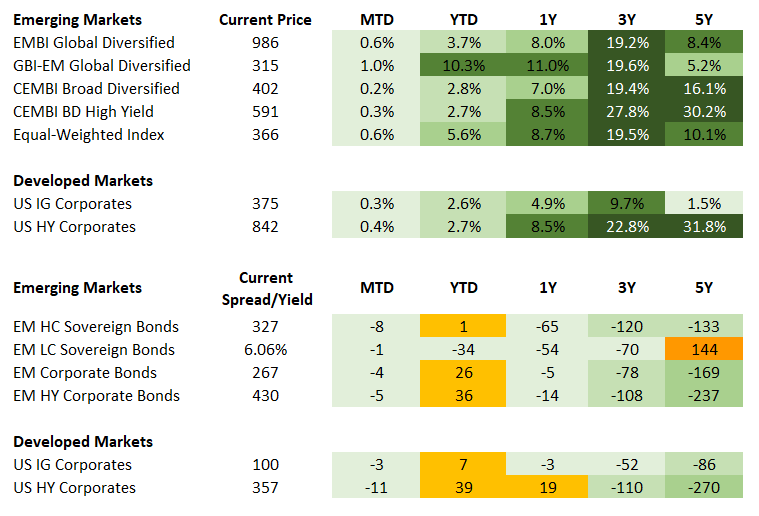
Equities
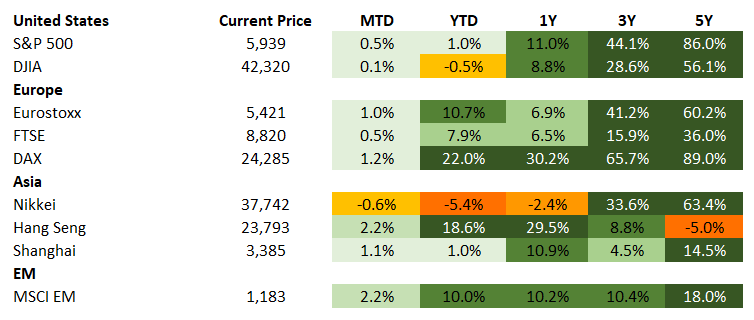
Commodities

Source for data tables: Bloomberg, JPMorgan, Gramercy. EM Fixed Income is represented by the following JPMorgan Indicies: EMBI Global, GBI-EM Global Diversified, CEMBI Broad Diversified and CEMBI Broad High Yield. DM Fixed Income is represented by the JPMorgan JULI Total Return Index and Domestic High Yield Index. Fixed Income, Equity and Commodity data is as of June 6, 2025 (mid-day).
Highlights
Ukraine Attacks Deep Inside Russia, Inflicting Significant Damage
Event: In a daring operation on June 1st, described by experts as “one of the great raids in military history that could change modern warfare,” Ukraine’s main security agency, the SBU, used hundreds of small, first-person-view drones to simultaneously attack military airfields thousands of miles inside enemy territory. They reportedly destroyed or damaged as many as 20 Russian aircraft, including Tu-95 strategic heavy nuclear bombers, Tu-22M3 supersonic long-range bombers, and very expensive early-warning planes. Separate deadly attacks on infrastructure in Russia’s Bryansk and Kursk regions and the Kerch Bridge that connects Russia to occupied Crimea also took place in the following days.
Gramercy Comment: As with the Kursk incursion last summer, Ukraine’s strategic objective with these attacks is to showcase Russia’s vulnerabilities, but above all, to gain leverage that could force the Kremlin to relax its maximalist pre-conditions for ceasefire talks. SBU’s operation, which disabled a portion of Russia’s heavy strategic bombers that had been actively used to attack Ukrainian targets, was planned for more than 18 months inside Russian territory. From that perspective, the recent events are a huge embarrassment for Russia’s security services, which failed to detect and prevent a remarkably complex operation on Russian soil. It was also a major boost to morale on Ukraine’s side.
Rather than edging President Putin toward some sort of mutually acceptable compromise to end the conflict, we think the recent events are likely to have the opposite effect and catalyze further entrenchment by the Kremlin in its strategic objective of de jure, or de facto, political control over Ukraine. In the meantime, a military escalation appears likely as President Putin has vowed a significant response to what he characterized as “terror acts” by Ukraine. The Russian President has rejected a face-to-face meeting with President Zelenskiy that Kyiv has repeatedly called for in recent weeks. As we’ve consistently argued, despite market hopes for a “resolution” to the war in Ukraine, we remain deeply skeptical about such a scenario given mutually exclusive objectives by the two sides and lack of binding constraints to force them into a compromise.
Poland’s Election Outcome Challenges Policy Outlook
Event: The right-wing, opposition-backed Mr. Nawrocki narrowly won Poland’s second-round presidential vote with 50.9% support. In the aftermath, Prime Minister Tusk called for a vote of confidence to be held on June 11th in an aim to bolster his center-left coalition. Later in the week, the National Bank of Poland kept its policy rate on hold at 5.25% in line with consensus.
Gramercy Comment: Mr. Nawrocki’s victory will likely pose significant headwinds to the Tusk government’s ability to execute its reform agenda, given the President’s ability to veto legislation passed by the Parliament. Importantly, reforms to restore judiciary independence are now unlikely, and fiscal loosening is anticipated into the 2027 parliamentary elections, potentially threatening Poland’s access to EU funding.
Prime Minister Tusk will likely survive the vote of confidence but with little improvement to governability dynamics. While government collapse and snap elections are not the base case, they cannot be ruled out given growing political polarization. In addition, Poland’s diplomatic clout in the EU will likely face headwinds in exchange for its closer ties to the U.S.
On the monetary policy front, higher political uncertainty leaves the NBP increasingly data dependent. Accordingly, Governor Adam Glapinski struck a more cautious and hawkish tone at the press conference this week – although better than expected near-term inflation dynamics still leave the door open for moderate cuts.
Mexico’s Judicial Elections Give Morena Full Control of Supreme Court
Event: On June 1st, Mexico held its unprecedented inaugural judicial election for all members of the Supreme Court, half of the country’s federal judges, and thousands of local-level roles. Voter turnout was low, at just 13%, amid apathy, limited knowledge of candidates and a complicated ballot process. This compares to 61% turnout in the presidential election last year. The Supreme Court and judicial discipline court results have been released, and all supreme court judges will be Morena-aligned. In addition, the majority of the new discipline court members have ties to former President Andres Manuel Lopez Obrador. The remaining results will be announced between now and June 10th.
Gramercy Comment: Morena’s anticipated sweep in the judicial vote cements President Claudia Sheinbaum’s already tight grip on power. While the politicalization of the judiciary poses risks to investor protection and court functionality, the outcome was not a surprise and thus largely a non-market event for now. Investors and rating agencies will watch how the judiciary changes impact the USMCA renewal process, as well as high profile cases, which could reveal legal deficiencies in an economy with rule of law weaknesses.
Emerging Markets Technicals
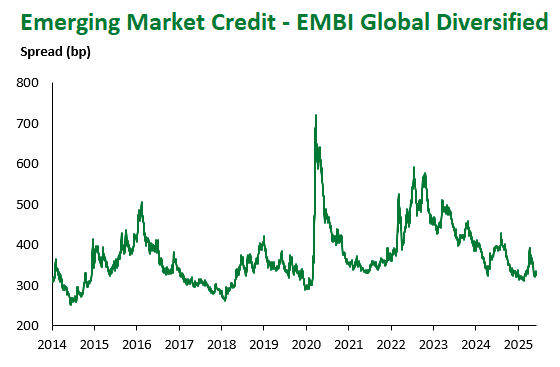
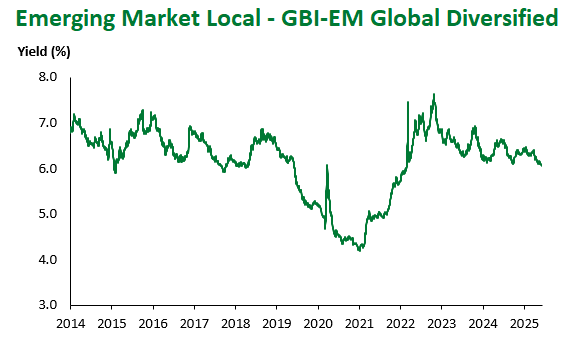
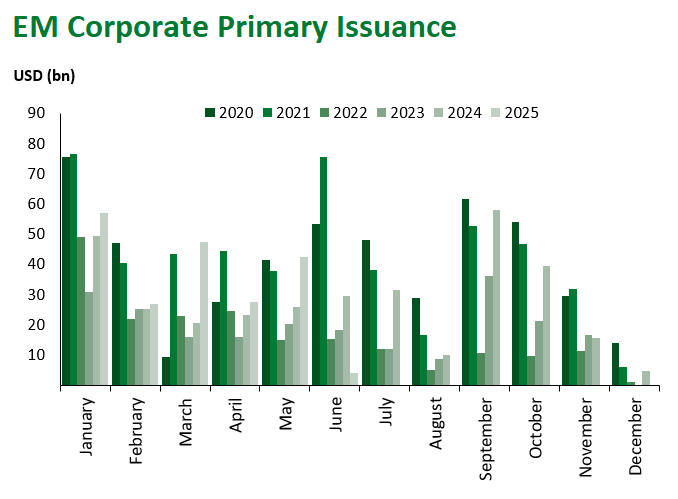

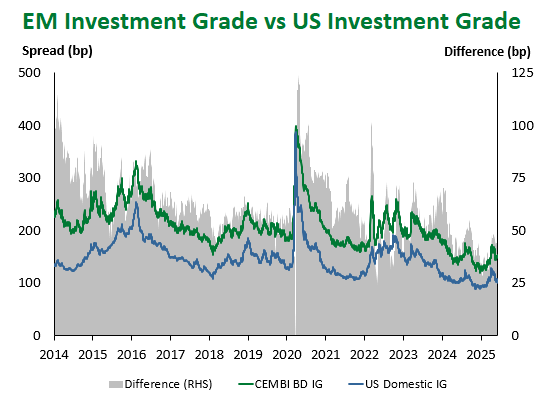
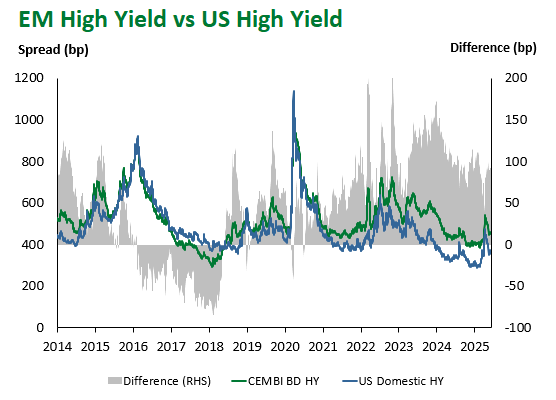

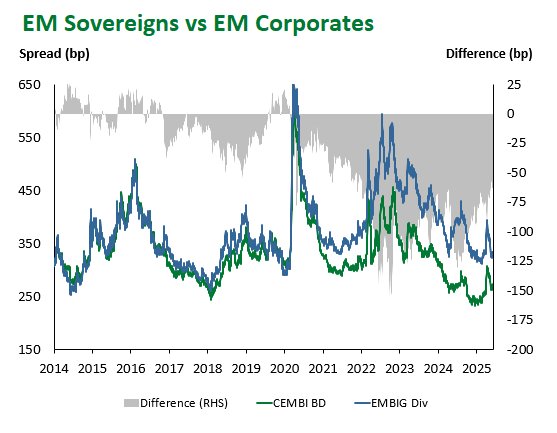
Emerging Markets Flows

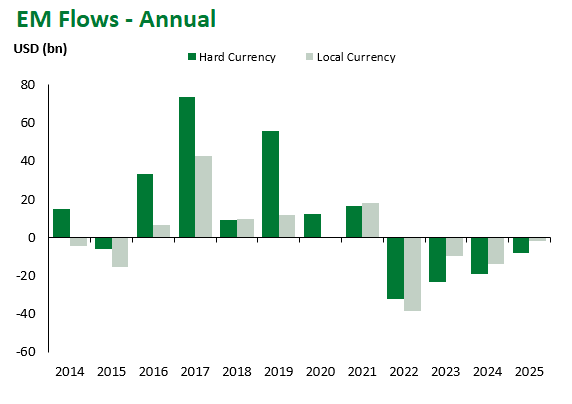
Source for graphs: Bloomberg, JPMorgan, Gramercy. As of June 6, 2025.
For questions, please contact:
Kathryn Exum, CFA ESG, Director, Co-Head of Sovereign Research, [email protected]
Petar Atanasov, Director, Co-Head of Sovereign Research, [email protected]
This document is for informational purposes only. The information presented is not intended to be relied upon as a forecast, research or investment advice, and is not a recommendation, offer or solicitation to buy or sell any securities or to adopt any investment strategy. Gramercy may have current investment positions in the securities or sovereigns mentioned above. The information and opinions contained in this paper are as of the date of initial publication, derived from proprietary and nonproprietary sources deemed by Gramercy to be reliable, are not necessarily all-inclusive and are not guaranteed as to accuracy. This paper may contain “forward-looking” information that is not purely historical in nature. Such information may include, among other things, projections and forecasts. There is no guarantee that any forecasts made will come to pass. Reliance upon information in this paper is at the sole discretion of the reader. You should not rely on this presentation as the basis upon which to make an investment decision. Investment involves risk. There can be no assurance that investment objectives will be achieved. Investors must be prepared to bear the risk of a total loss of their investment. These risks are often heightened for investments in emerging/developing markets or smaller capital markets. International investing involves risks, including risks related to foreign currency, limited liquidity, less government regulation, and the possibility of substantial volatility due to adverse political, economic or other developments. References to any indices are for informational and general comparative purposes only. The performance data of various indices mentioned in this update are updated and released on a periodic basis before finalization. The performance data of various indices presented herein was current as of the date of the presentation. Please refer to data returns of the separate indices if you desire additional or updated information. Indices are unmanaged, and their performance results do not reflect the impact of fees, expenses, or taxes that may be incurred through an investment with Gramercy. Returns for indices assume dividend reinvestment. An investment cannot be made directly in an index. Accordingly, comparing results shown to those of such indices may be of limited use. The information provided herein is neither tax nor legal advice. Investors should speak to their tax professional for specific information regarding their tax situation.
